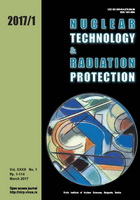
ELECTRONIC STRUCTURE AND CHEMICAL BOND NATURE IN Cs2NpO2Cl4
Pages: 1-9
Authors: Yury A. Teterin, Konstantin I. Maslakov, Mikhail V. Ryzhkov, Anton Yu. Teterin,
Kirill E. Ivanov, Stepan N. Kalmykov, Vladimir G. Petrov, and Dmitry N. SuglobovAbstract
On the basis of the X-ray photoelectron spectroscopy data and results of theoretical calculations for the Cs2NpO2Cl42- (D4h) cluster, the electronic structure and the chemical bond nature in Cs2NpO2Cl4 single crystal, containing the neptunyl group NpO22+, was done in the binding energy range of 0 eV to ~35 eV. The filled Np 5f electronic states were established to form in the valence band of Cs2NpO2Cl4. This was attributed to the direct participation of the Np 5f electrons in the chemical bonding. The Np 6p electrons were shown to participate in formation of both the inner valence band (~15 eV-~35 eV) and the outer valence band (0 eV-~15 eV). The filled Np 6p and the O 2s, Cl 3s electronic shells were found to make the largest contribution to the formation of the inner valence molecular orbitals. The molecular orbitals composition and the sequence order in the binding energy range 0 eV-~35 eV in Cs2NpO2Cl4, were established. For the first time the quantitative scheme of molecular orbitals for the NpO2Cl42- cluster in the binding energy range 0 eV-~35 eV, was built. This scheme reflects neptunium close environment in the studied compound and is fundamental for both understanding the chemical bond nature in Cs2NpO2Cl4 and the interpretation of other X-ray spectra of Cs2NpO2Cl4. The contributions to the chemical binding for the NpO2Cl42- cluster were evaluated to be: the outer valence molecular orbitals contribution – 73 %, and the inner valence molecular orbitals contribution – 27 %.
Key words: actinide, neptunium, electronic structure, XPS, relativistic calculation
FULL PAPER IN PDF FORMAT (688 KB)
